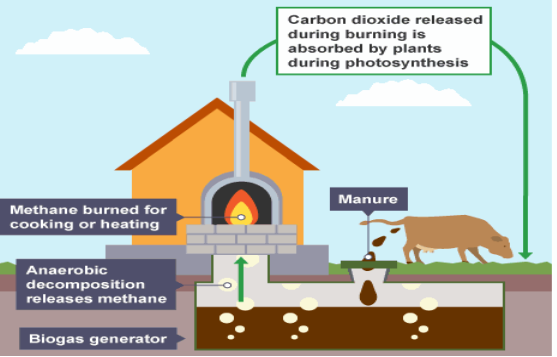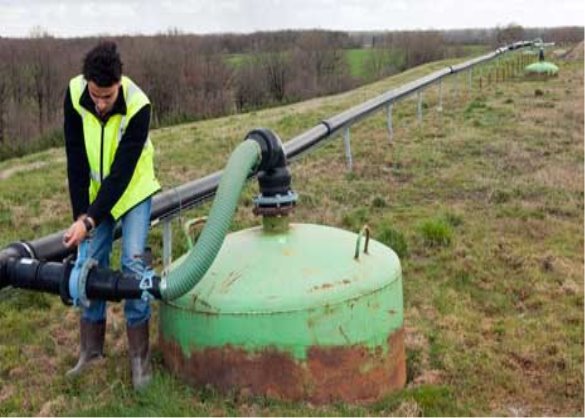The composition of biological gas varies depending on how it is obtained and which kind of raw materials are used for it. Biological gas is characterized by stability, which is produced with the help of biological gas plants by fermenting raw materials under the influence of bacteria. As raw materials are usedas organic wastes, as well as garbage and plant waste. In the methane decomposition of the raw mass participate in forming hydrolytic, acid and methane bacteria. Biological gas is formed in the process of decomposition of organic substances on fats, sugar and amino acids, interacting with methanogenic bacteria. Biological gas, obtained in biological gas plants, is a mixture of gases, among which the largest percentage is methane and carbon dioxide. In addition to these gases in the composition present hydrogen, hydrogen sulphide and others. Biological gas can be biomethane or biohydrogen. Biomethane is an analogue of a of a natural gas. Its basis is methane.
Approximately biological gas components are in the following proportions:
– Methane is 40–70 %
– Carbon dioxide is 30–60 %
– Hydrogen sulfide is 0–3 %
– Hydrogen is 0–1 %
– Other gases is 1–5 %
55 % methane content in biological gas allows it to be used as a source of energy in heating system, engines, gas columns and stoves.
The quality of biological gas is directly dependent on the quality and composition of biological mass. Carbohydrates that make up a raw substrate give less methane than proteins and fats. For example, corn contains a lot of carbohydrates, from it you can get less than 53 % of methane. Raw materials in which more fats, will give a high percentage of methane in biological gas, thereby increasing its energy value. But the excess of fat leads to inhibition of the process of biological gas formation and even to its complete stop. Therefore, the composition of raw materials should be regularly monitored. 60 percent of methane makes biological gas valuable fuel. Methane has no color and smell, it is lighter than air. Does not have toxicity. Steam and carbon are produced when it is burned. In biological gas plants of a single-stage type, the decomposition of raw materials is carried out in one fermenter, so biological gas is a gas mixture. Therefore, biological gas is a gas mixture. Installations of a two-stage type allow at the first stage to remove insignificant gases. And at the second get gas with a large percentage of methane.
In addition to methane and carbon dioxide, the composition of the biological gas includes hydrogen sulphide, which has an aggressive effect on equipment, cylinders, burners. Chlorine, fluorine are also aggressive. This is why a technology for the removal of hydrogen sulphide and hydrocarbons containing halogens is provided on bio-units. Biological gas without sulfur has practically no characteristic odor. And the absence of hydrocarbons containing chlorine and fluorine in it makes the gas less aggressive. To transport biological gas, it should be compressed and liquefied. Before liquefaction or compression, the gas is completely purified from impurities, hydrogen sulphide, carbon dioxide.
The biological gas composition makes it possible to use it as an unconventional source of energy, and its production prevents the increase of methane content in the atmosphere, which is important from the ecological point of view.
The principle of biological exhaust gas cleaning is based on microorganisms converting the contents of exhaust gas into harmless products. As the process always has to take place in a more aqueous phase than is available in the microorganisms' habitat, the microorganisms are either grown in a film of moisture on a substrate or suspended in an aqueous solution. The microorganisms are aerobic bacteria that oxidize the contents when oxygen is present.
The degradation performance of the micro-organisms is highly dependent on the environmental conditions: not only must enough oxygen and nutrients be available, but the temperature, pH and moisture levels also have a key role to play. Unlike a bio-filter, the advantage of a bio-scrubber is that it can control microbiological contamination on the exchange surface and keep this at a sufficiently low level.
Biogas is a biofuel produced from the anaerobic fermentation of carbohydrates in plant material or waste (e.g. Food peeling of manure) by bacteria.
It is mainly composed of methane, with some carbon dioxide and other trace gases. However, the proportion of methane within the biogas can vary between 50 % and 80 % depending whether some oxygen is able to enter at the beginning or during the process. If some oxygen is present the bacteria will respire aerobically and will produce a gas with a higher proportion of carbon dioxide and a lower proportion of methane.
Biogas can be produced on a small scale in a biogas generator, which can be made of simple materials.
The carbohydrate — containing materials are fed in, and a range of bacteria anaerobically ferment the carbohydrate into biogas. The remaining solids settle to the base of the digester and can be run off to be used as fertilizer for the land. These types of biogas generator are most commonly used in the developing world to satisfy the needs of a small family.

The optimum temperature for biogas production is between 32 C and 35 C. temperatures above and below this optimum can result in less biogas being produced, which can be a problem in hotter and cooler countries (see table below).
|
Country |
Problems |
Solution |
|
Cooler country |
Temperature below optimum slow the respiration rate of bacteria resulting in slower biogas production |
Bury the biogas generator or build the biogas generator with thick walls to insulate the generator and keep the inside warmer than the external temperature |
|
Hotter country |
Temperature above optimum begin to denature bacterial enzymes, resulting in slower biogas production |
Bury the biogas generator in the ground. The ground helps to insulate the biogas generator to keep it cool during the day and warm at night. |
If a bigger, more sophisticated biogas generator is used, biogas can also be produced on a large scale.

Biogas is naturally produced in landfill sites as bacteria anaerobically break down our rubbish, but normally the methane escapes into the atmosphere where it contributes to global warming. If a pipe network with holes in it can be built into the land fill site — and the methane is prevented from escaping into the atmosphere by covering the site — then the methane can be collected via the pipe network.

The methane can then be used as a fuel to generable electricity or heat buildings, eg. care homes, hospitals and schools. This is an example of biogas generation on a commercial scale.
References:
- Energy Cube Biological Scrubber & Gas Handling Equipment . [Электронный ресурс]. — URL: energycubellc.com (дата обращения: 21.06.2017).
- Renewable Energy Concepts. [Электронный ресурс]. — URL: www.rec-energy.com (дата обращения: 21.06.2017).







